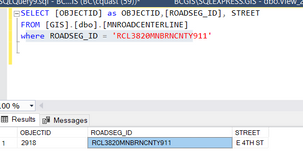- Home
- :
- All Communities
- :
- Products
- :
- ArcGIS Enterprise
- :
- ArcGIS Enterprise Questions
- :
- OBJECTID in SQL Express table not matching ObjectI...
- Subscribe to RSS Feed
- Mark Topic as New
- Mark Topic as Read
- Float this Topic for Current User
- Bookmark
- Subscribe
- Mute
- Printer Friendly Page
OBJECTID in SQL Express table not matching ObjectID in ARCMAP/PRO
- Mark as New
- Bookmark
- Subscribe
- Mute
- Subscribe to RSS Feed
- Permalink
I'm trying to create a view based on a union between two datasets that are exactly the same format. And it seems to work, except a newly added line segment is missing.
After spending the morning I think I have it figured out why and its not the union, but something to do with how SQL Express pulls records. I'm not sure how to fix this.
The below information is just looking at the main table, no union.
So this is the result when I look for one specific ID in SQL Express - notice that the OBJECTID is 2918, and pulls up 4th St (Not Correct)
Than in ArcPro (and ArcMap), the Object ID is 3820 (which is correct) and pulls 190th Ave (which is correct)
When I create a view and look at it in ArcPro, this 'shift' in the table is in that view.
For a bit of background, I have roads for our 911 system that is also used for run general day to day applications. A few of these roads have multiple names. Overlapping segments in the 911 system isn't allowed, But for the rest of my users, they need to be able to see/have all the names, road classifications, etc. So I have the main 911 roads unioned with the overlapping segments layer as a view in SQL Express and my general users can use this view.
I'm really new to this, so it very possible I'm missing something easy.
I'm running Windows Server 2016 Standard, and SQL Server Express, version 14
Solved! Go to Solution.
Accepted Solutions
- Mark as New
- Bookmark
- Subscribe
- Mute
- Subscribe to RSS Feed
- Permalink
So - I'm not sure if version was causing my union to miss the newest segment, but the pointer made me look closer at the settings - I ran a GeoDatabase Compression on the database, and than added a secondary index in SQL Express. Not sure which of these fixed the problem, but I got it working.
- Mark as New
- Bookmark
- Subscribe
- Mute
- Subscribe to RSS Feed
- Permalink
If the data is versioned, you want to be querying the versioned views and not the base tables because the base tables might not represent the state of the data you are seeing in Pro.
- Mark as New
- Bookmark
- Subscribe
- Mute
- Subscribe to RSS Feed
- Permalink
They are versioned - I'll have to look into this!
- Mark as New
- Bookmark
- Subscribe
- Mute
- Subscribe to RSS Feed
- Permalink
So - I'm not sure if version was causing my union to miss the newest segment, but the pointer made me look closer at the settings - I ran a GeoDatabase Compression on the database, and than added a secondary index in SQL Express. Not sure which of these fixed the problem, but I got it working.

